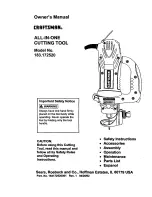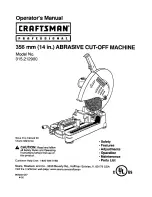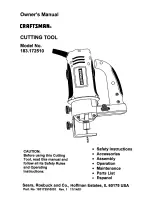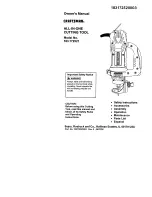
13
Power tool use and care
Do not force the power tool. Use the correct
power tool for your application.
The correct
power tool will do the job better and safer at the rate for
which it was designed.
Do not use the power tool if the switch does not
turn it on and off.
Any power tool that cannot be con-
trolled with the switch is dangerous and must be repaired.
Disconnect the plug from the power source
and/or the battery pack from the power tool
before making any adjustments, changing
accessories, or storing power tools.
Such preven-
tive safety measures reduce the risk of starting the power
tool accidentally.
Store idle power tools out of the reach of chil-
dren and do not allow persons unfamiliar with
the power tool or these instructions to operate
the power tool.
Power tools are dangerous in the
hands of untrained users.
Maintain power tools. Check for misalignment
or binding of moving parts, breakage of parts
and any other condition that may affect the
power tool’s operation. If damaged, have the
power tool repaired before use.
Many accidents
are caused by poorly maintained power tools.
Keep cutting tools sharp and clean.
Properly
maintained cutting tools with sharp cutting edges are less
likely to bind and are easier to control.
Use the power tool, accessories and tool bits
etc. in accordance with these instructions, tak-
ing into account the working conditions and
the work to be performed.
Use of the power tool
for operations different from those intended could result in
a hazardous situation.
Battery tool use and care
Recharge only with the charger specified by
the manufacturer.
A charger that is suitable for one
type of battery pack may create a risk of fire when used
with another battery pack.
Use power tools only with specifically desig-
nated battery packs.
Use of any other battery packs
may create a risk of injury and fire.
When battery pack is not in use, keep it away
from other metal objects, like paper clips,
coins, keys, nails, screws or other small metal
objects, that can make a connection from one
terminal to another.
Shorting the battery terminals
together may cause burns or a fire.
Under abusive conditions, liquid may be ejected
from the battery; avoid contact. If contact acci-
dentally occurs, flush with water. If liquid con-
tacts eyes, additionally seek medical help.
Liquid
ejected from the battery may cause irritation or burns.
Service
Have your power tool serviced by a qualified
repair person using only identical replacement
parts.
This will ensure that the safety of the power tool is
maintained.
Machine-specific Safety Warnings
Hold power tool by insulated gripping sur-
faces, when performing an operation where
the cutting accessory may contact hidden wir-
ing.
Cutting accessory contacting a “live” wire may make
exposed metal parts of the power tool “live” and could
give the operator an electric shock.
Use the machine only for dry sanding.
Penetra-
tion of water into the machine increases the risk of an elec-
tric shock.
Caution, fire hazard! Avoid overheating the
object being sanded as well as the sander.
Always empty the dust collector before taking
breaks.
In unfavourable conditions, e. g., when sparks
emit from sanding metals, sanding debris in the dust bag,
micro filter or paper sack (or in the filter sack or filter of the
vacuum cleaner) can self-ignite. Particularly when mixed
with remainders of varnish, polyurethane or other chemi-
cal materials and when the sanding debris is hot after long
periods of working.
Keep hands away from the sawing range. Do
not reach under the workpiece.
Contact with the
saw blade can lead to injuries.
Wait until the machine has come to a standstill
before placing it down.
Use appropriate detectors to determine if util-
ity lines are hidden in the work area or call the
local utility company for assistance.
Contact with
electric lines can lead to fire and electric shock. Damaging
a gas line can lead to explosion. Penetrating a water line
causes property damage.
When working with the machine, always hold
it firmly with both hands and provide for a
secure stance.
The power tool is guided more secure
with both hands.
Secure the workpiece.
A workpiece clamped with
clamping devices or in a vice is held more secure than by
hand.
Keep your workplace clean.
Blends of materials
are particularly dangerous. Dust from light alloys can burn
or explode.
Do not open the battery.
Danger of short-circuiting.
Protect the battery against heat, e. g.,
against continuous intense sunlight, fire,
water, and moisture.
Danger of explosion.
OBJ_BUCH-1106-003.book Page 13 Thursday, October 27, 2016 2:00 PM
Summary of Contents for EMS 12-A
Page 88: ...88 FI RCD OBJ_BUCH 1106 003 book Page 88 Thursday October 27 2016 2 00 PM...
Page 89: ...89 OBJ_BUCH 1106 003 book Page 89 Thursday October 27 2016 2 00 PM...
Page 149: ...149 OBJ_BUCH 1106 003 book Page 149 Thursday October 27 2016 2 00 PM...
Page 150: ...150 OBJ_BUCH 1106 003 book Page 150 Thursday October 27 2016 2 00 PM...
Page 151: ...151 OBJ_BUCH 1106 003 book Page 151 Thursday October 27 2016 2 00 PM...
Page 180: ...180 OBJ_BUCH 1106 003 book Page 180 Thursday October 27 2016 2 00 PM...
Page 181: ...181 OBJ_BUCH 1106 003 book Page 181 Thursday October 27 2016 2 00 PM...
Page 182: ...182 OBJ_BUCH 1106 003 book Page 182 Thursday October 27 2016 2 00 PM...
Page 187: ...187 W rth 0 70 C 20 C 50 C OBJ_BUCH 1106 003 book Page 187 Thursday October 27 2016 2 00 PM...














































